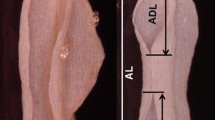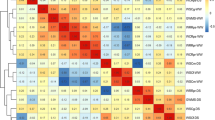Abstract
In floating rice, stem elongation begins much earlier than in non-floating rice, which is the major survival mechanism for flooding. Inheritance of this early elongation ability was studied using diallel and quantitative trait locus (QTL) analyses. The diallel analysis was undertaken using a set of 6×6 half-diallel crosses involving four floating (‘Goai’, ‘Habiganj Aman VIII’, ‘Badal 106’, and Oryza rufipogon strain W120) and two non-floating (‘Latisail’ and ‘Patnai 23’) parents. The additive gene effects were higher than the dominant effects. The dominant alleles were concentrated in the cultivated floating parents (‘Goai’, ‘Habiganj ‘Aman VIII’, and ‘Badal 106’), whereas the recessive alleles were in the wild floating parent (W120). A QTL analysis using a ‘Patnai 23’ × ‘Goai’ F2 population detected two putative QTLs. Of these QTLs, the one on chromosome 12 behaved as a partially dominant major gene that explained more than half of the total genetic variation.


Similar content being viewed by others
References
Baker RJ (1978) Issues in diallel analysis. Crop Sci 18:533–536
Catling D (1992) Rice in deep water. International Rice Research Institute, Manila, Philippines
Chen X, Temnykh S, Xu Y, Cho YG, McCouch SR (1997) Development of a microsatellite framework map providing genome-wide coverage in rice (Oryza sativa L.). Theor Appl Genet 95:553–567
Eiguchi M, Hirano H, Sano Y, Morishima H (1993a) Effects of water depth on internodal elongation and floral induction in a deepwater-tolerant rice line carrying the dw3 gene. Jpn J Breed 43:135–139
Eiguchi M, Sano R, Hirano H, Sano Y (1993b) Genetic and developmental basis for phenotypic plasticity in deepwater rice. J Hered 84:201–205
Glaszmann JC (1987) Isozymes and classification of Asian rice varieties. Theor Appl Genet 74:21–30
Hakoda H, Inoue J (1988) Classification of Asian deepwater rices based on acid phosphatase and esterase isozymes. In: Proceedings of the 1987 international deepwater rice workshop. International Rice Research Institute, Manila, Philippines, pp 381–385
Hamamura K, Kupkanchanakul T (1979) Inheritance of floating ability in rice. Jpn J Breed 29:211–216
Hamamura K, Saengpetch P (1977) Techniques to distinguish floating rice from non-floating types in seedling stage. In: Proceedings of the 1976 International Deepwater Rice Workshop. International Rice Research Institute, Manila, Philippines, pp 93–100
Harushima Y, Kurata N, Yano M, Nagamura Y, Sasaki T, Minobe Y, Nakagahra M (1996) Detection of segregation distortion in an indica-japonica rice cross using a high-resolution molecular map. Theor Appl Genet 92:145–150
Hayman BI (1954a) The analysis of variance of diallel tables. Biometrics 10:235–244
Hayman BI (1954b) The theory and analysis of diallel crosses. Genetics 39:789–809
Huang N, Courtois B, Khush GS, Lin H, Wang G, Wu P, Zheng K (1996) Association of quantitative trait loci for plant height with major dwarfing genes in rice. Heredity 77:130–137
Inoue J (1983) Relation between elongation ability and internode elongation of floating rice under rising water conditions. Jpn J Trop Agric 27:181–186
Inoue J, HilleRisLambers D, Chitrakon S (1985) Some morphological and ecological differences between floating and non-floating rice varieties in Thai paddy rice, Oryza sativa L. Bull Inst Trop Agric Kyushu Univ 8:55–89
Islam QR, Inoue J (1988) Elongation ability and some morphological characteristics of deepwater rice in Bangladesh. In: Proceedings of the 1987 International Deepwater Rice Workshop. International Rice Research Institute, Manila, Philippines, pp 223–229
Kende H, van der Knaap E, Cho HT (1998) Deepwater rice: a model plant to study stem elongation. Plant Physiol 118:1105–1110
Kurata N, Nagamura Y, Yamamoto K, Harushima Y, Sue N, Wu J, Antonio BA, Shomura A, Shimizu T, Lin SY, Inoue T, Fukuda A, Shimano T, Kuboki Y, Toyama T, Miyamoto Y, Kirihara T, Hayasaka K, Miyao A, Monna L, Zhong HS, Tamura Y, Wang ZX, Momma T, Umehara Y, Yano M, Sasaki T, Minobe Y (1994) A 300-kilobase-interval genetic map of rice including 883 expressed sequences. Nat Genet 8:365–372
Lander ES, Green P, Abrahamson J, Barlow A, Daly MJ, Lincoln SE, Newburg L (1987) MAPMAKER: an interactive computer package for constructing primary genetic linkage maps of experimental and natural populations. Genomics 1:174–181
Lincoln SE, Daly MJ, Lander ES (1992) Mapping genes controlling quantitative traits with MAPMAKER/QTL 1.1. Whitehead Institute Technical Report, 2nd edn. Whitehead Institute, Cambridge, Mass.
Mazaredo AM, Vergara BS (1979) Screening for ability to elongate at an early stage of growth. In: Proceedings of the 1978 International Deepwater Workshop. International Rice Research Institute, Manila, Philippines, pp 143–144
McCouch SR, Teytelman L, Xu Y, Lobos KB, Clare K, Walton M, Fu B, Maghirang R, Li Z, Xing Y, Zhang Q, Kono I, Yano M, Fjellstrom R, DeClerck G, Schneider D, Cartinhour S, Ware D, Stein L (2002) Development and mapping of 2,240 new SSR markers for rice (Oryza sativa L.). DNA Res 9:199–207
Metraux J-P, Kend H (1984) The cellular basis of the elongation response in submerged deepwater rice. Planta 160:73–77
Morishima H, Hinata K, Oka HI (1962) Floating ability and drought tolerance in wild and cultivated species of rice. Indian J Genet Plant Breed 22:1–11
Nemoto K, Morita S, Baba T (1995) Shoot and root development in rice related to the phyllochron. Crop Sci 35:37–43
Quarrie SA, Laurie AD, Zhu J, Lebreton C, Semikhodskii A, Steed A, Witsenboer H, Calestani C (1997) QTL analysis to study the association between leaf size and abscisic acid accumulation in droughted rice leaves and comparisons across cereals. Plant Mol Biol 35:155–165
Sripongpangkul K, Posa GBT, Senadhira DW, Brar D, Huang N, Khush GS, Li ZK (2000) Genes/QTLs affecting flood tolerance in rice. Theor Appl Genet 101:1074–1081
Suge H (1988) Physiological genetics of internode elongation in submerged deepwater rice. In: Proceedings of the 1987 International Deepwater Rice Workshop. International Rice Research Institute, Manila, Philippines, pp 275–285
Takahashi K (1988) Hormonal regulation of internode elongation in rice shoots. In: Proceedings of the 1987 International Deepwater Rice Workshop. International Rice Research Institute, Manila, Philippines, pp 245–255
Thakur R, HilleRisLambers D (1988) Inheritance of elongation ability in rice. In: Proceedings of the 1987 International Deepwater Rice Workshop. International Rice Research Institute, Manila, Philippines, pp 269–274
Tripathi RS, Rao MJB (1985) Inheritance studies of characters associated with floating habit and their linkage relationship in rice. Euphytica 34:875–881
Ukai Y (1989) A microcomputer program DIALL for diallel analysis of quantitative characters. Jpn J Breed 39:107–109
Zhu H, Qu F, Zhu LH (1993) Isolation of genomic DNAs from plants, fungi and bacteria using benzyl chloride. Nucleic Acids Res 21:5279–5280
Acknowledgements
We thank Dr. Hideshi Yasui (Kyushu University), Dr. Masahiro Yano (National Institute of Agrobiological Sciences), and Dr. Kiyoshi Takahashi (Tohoku University) for their valuable suggestions on experimental design; Dr. Yasushi Takano (The University of Tokyo) for his valuable advise on statistical analysis; Dr. M.T. Jackson (IRRI) for kindly providing the seeds of the accessions from the Gene Bank; Professor Yoshio Sano (Hokkaido University) for kindly providing the W120 seeds; and Mrs. Mitsuko Konno (The University of Tokyo) for her technical support.
Author information
Authors and Affiliations
Corresponding author
Additional information
Communicated by D.J. Mackill
Rights and permissions
About this article
Cite this article
Nemoto, K., Ukai, Y., Tang, DQ. et al. Inheritance of early elongation ability in floating rice revealed by diallel and QTL analyses. Theor Appl Genet 109, 42–47 (2004). https://doi.org/10.1007/s00122-004-1600-5
Received:
Accepted:
Published:
Issue Date:
DOI: https://doi.org/10.1007/s00122-004-1600-5




